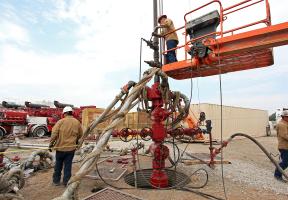How Does an Anaerobic Digester Work?
10 min read
digestion, or methanization, uses the process of to break down organic matter from animals, plants or sewage to produce . The process takes place within a centralized system in a unit called an anaerobic digester, also known as a biogas reactor or a biodigester.

©
A digester is a tank, whose size and appearance varies considerably depending on what it is used for. A household digester for a single family can have a volume of less than one cubic meter, whereas an industrial-scale unit can easily surpass 5,000 cubic meters. A digester on a farm or a ranch typically has a capacity of a few dozen cubic meters.
How Anaerobic Digestion Works
All anaerobic digestion systems adhere to the same working principle.
1. Loading
The particles of solid or liquid matter are crushed to obtain a homogenized substrate that is fed by a hopper into an anaerobic, or oxygen-free vessel of cylindrical form. Feedstocks include grains (the most efficient), molasses, animal fat, cattle and chicken manure, household waste and sewage sludge.
2. Fermentation
The
is heated to approximately 37°C to 38°C (sometimes more than 50°C) and stirred continuously. After at least 20 days and a series of
-induced chemical transformations, the fermented biomass produces biogas. The biogas contains 40% to 70%
, the same as natural gas from a
. The remaining gas is carbon dioxide (
), plus small amounts of sulfur.
3. Biogas uses
The biogas may be used on-site in a
engine for producing heat and
or it can be purified with membranes to extract the methane for
into the public natural gas network or for use as transportation
.
4. Removal
The
, or material left over following the conversion of the substrate, is typically used as fertilizer for crops.
In addition to the digester, a biogas plant includes a facility for storing and sorting the waste material, a gas holder for storing the gas, a cogeneration unit for producing heat and power and a control room for monitoring the various operations. Biogas production remains low relative to natural gas demand: it represented 4% of total European natural gas consumption in 2015.
Different Types of Anaerobic Digesters
On-Farm Digester
In a farm or ranch set-up, crop residues and manure, and sometimes waste from neighboring communities, are placed in a half-buried concrete pit with an impermeable cover. The biogas is temporarily collected under the cover before being transported to a storage tank, where it can later be retrieved. The digestate may be returned to the tank where it can continue to be used or applied as a soil conditioner. The operations need to be monitored daily to ensure the process is under control and the gas pipes are working safely. Power capacity varies widely from one unit to another. In France, the average capacity of a farm digester is 200 kilowatts (see box).
Biogas Plant
A large-scale biogas plant processes tons of household or industrial waste (food, paper and other industry residues) from dozens of communities. The material needs to be sorted to separate the organic matter from any solid waste, such as plastic and packaging, that happens to be present. The organic feedstock is then macerated and pumped into steel towers, which can exceed a height of 30 meters. The biogas is collected and stored in a gas holder. A biogas facility is often located near an industrial plant that it supplies with gas or . In France, centralized biogas plants have an average power capacity of 1,200 kilowatts. Due to investment costs, operating expenses and network access tariffs, gas injection projects are prohibitively expensive for small biogas units.
Wastewater Plants and Sewage Treatment
Water treatment plants remove contaminants from household and industrial wastewater. The cleaned water is released into rivers, while the thickened sludge may be used to produce biogas, albeit with a lower yield than crop residues and manure feedstocks. In a continuous flow system, the sludge is treated in larges vessels covered by a metal dome and is constantly stirred by large machines called agitators.
Micro-Scale Anaerobic Digestion
Small-scale units (power capacity of less than 50 kilowatts) are suited for neighborhood, municipal, restaurant or domestic applications. Some units comprised of two plastic compartments, one for fermentation and one for gas storage, cost only a few hundred euros. Small digesters can also be hooked up to a generator to produce electricity. The drawback of micro-scale digesters is that they have a startup time of several weeks and require permanent maintenance. In countries where energy access is low, home-made units are frequently used for heating, cooking and lighting. In China, more than 40 million households have an anaerobic digester.
Is Anaerobic Digestion Economically Viable ? Example of a farm
A French dairy farm with 140 cows produces about 1,400 metric tons of manure per year. The manure is fed into a digester with a capacity of 55 kilowatts. In one year, the digester generates 281,000 kilowatt-hours of thermal energy (heat) and 117,000 kilowatt-hours of electricity.
The heat is used to warm the barn and other farm buildings. The electricity has two main applications:
- Power the machinery for feeding, milking and taking care of the 140 cows, which uses close to 60,000 kilowatt-hours per year.
- Run the biogas generator, which consumes 8,000 kilowatt-hours.
The remaining 49,000 kilowatt-hours of electricity are sold to the power utility at a rate that is adjusted annually.
In this example, the farmer received €10,780 from the sale of the electricity and various premiums. In addition, he saved €8,400 by using the produced electricity and heat to operate the farm.
In all, he “earned” a little over €19,000 in one year. Based on an initial investment of around €300,000, it will take 15 years for the investment in the 50 kilowatt unit to pay for itself. After that, the farmer will be able to generate additional revenue, even after deducting for maintenance.






















